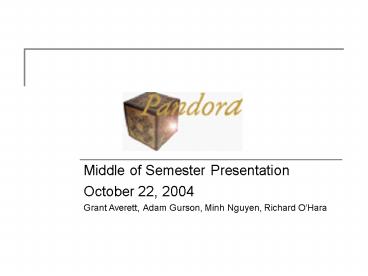Middle of Semester Presentation - PowerPoint PPT Presentation
1 / 15
Title: Middle of Semester Presentation
1
- Middle of Semester Presentation
- October 22, 2004
- Grant Averett, Adam Gurson, Minh Nguyen, Richard
OHara
2
Pandora Project Background
- Students are full time employees of Integrity
Applications Incorporated - Project objective develop a generic analysis
framework that could be applied to various
problem sets
3
Pandora Team Goals
- Create the Process and Management framework
necessary to successfully complete our project
and demonstrate to IAI that a more formal process
can make software development a less risky
proposition - Develop a Generic Framework
- Parsers Read incoming data
- Models Expected behavior of a system
- Correlators Compare input data sources and
expected behavior - Develop a Demonstration Capability
- Model a satellite system to include parsing of
incoming data, comparison of planned versus
actual data, notification of anomalies
4
Current Roles
- Team Lead
- Minh Nguyen
- Customer Liaison
- Grant Averett
- Configuration Management
- Adam Gurson
- SOW Lead
- Richard OHara
5
Current Status
- Proposal Drafts Complete
- Statement of Work Draft Near Complete
- Waiting for clarification from customer to
identify specific data sources - Critical requirements have been identified
- Project Lifecycle Defined
- Artifact based lifecycle
- Formal requirements stage with formal
requirements specification - Formal design stage with UML artifacts
- Implementation after design completion
- Testing refinement throughout lifecycle
6
Lessons Learned
- Formal agenda and management of meetings lead to
more productive sessions - Freeze artifacts 24 hours before meetings
- Allows participants enough time to review
artifacts more productive discussions
7
Lessons Learned (continued)
- Team Communication Difficulties
- Too much email traffic
- Lack of team coordination
- Risk Mitigation Strategy
- Weekly Team Meetings
8
Current Risks
- 40 hour work week versus demands of studio
project - Difficult to align team schedules
- Summer semester of 30 hour studio
- Team progress slow as we are defining roles,
processes - Work environment encourages code over process
- Lack of identification of specific data sources
- Prevents completion of SOW, complete definition
of Use Cases
9
Questions?
- How do you validate requirements that you cannot
visualize? - How do you capture quality attributes as atomic
and testable requirements? - Will use cases and stereotypes capture functional
and non-functional requirements? - How do you plan for changes to your schedule
because of activities creep? - How have other teams overcome communication
problems?
10
Backup Slides
11
The Analysis Triad
12
Parsers What data do we have?
- Convert raw input data into structured data
- Usually one parser for each type of input data
- Store parsed data into structured (but
uncorrelated) databases - Could have some primitive internal correlation to
generate structured data types from multiple raw
data fields
13
Models What data are we expecting to have?
- Digitized Domain Knowledge
- Can be manually entered by an expert user or
generated by a correlator from historical data - Represents known trends or anomalies (i.e. the
magnetic field over X lat Y lon always causes a
satellite to temporarily lose communication
capabilities) - May need to be updated over time as correlator
discovers consistent discrepancies between the
model and parsed data
14
Correlators How do they differ?
- Compare parsed input data against model to
determine possible anomalies or discrepancies - Could be used to generate model from scratch from
historical data - Could have any number of correlators across
different data sets, each looking for different
trends/discrepancies - Trigger communications (i.e. JMS events) with
users when anomalies are detected - Store correlated output data in correlated
database
15
Possible Architecture
Event Channel
User 1
Receive Anomaly Events
Input Domain Knowledge Into Model
User n
GenerateAnomalyEvents
Query/ViewCorrelated Data
Query/View Raw Data
Models
M
M
Parsed Data
Correlated Data
PD
PD
PD
CD
CD
CD
ReadModel
C
Read Raw Data
P
P
P
Parsers
Correlators
C
Generate Model
Raw Input Data































